-
Posts
2,284 -
Joined
-
Last visited
-
Days Won
6
Content Type
Profiles
Forums
Blogs
Gallery
Events
Store
Posts posted by PKeating
-
-
This fake bears a B&NL hallmark. The diving eagle is again of the 1957 pattern but appears to be cast from an original striking.
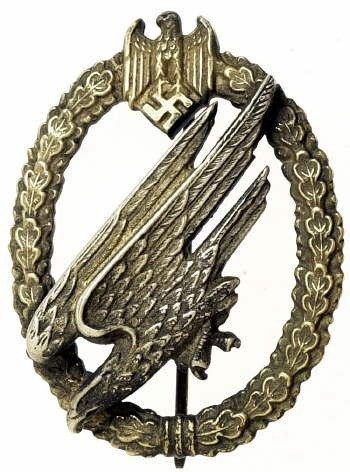
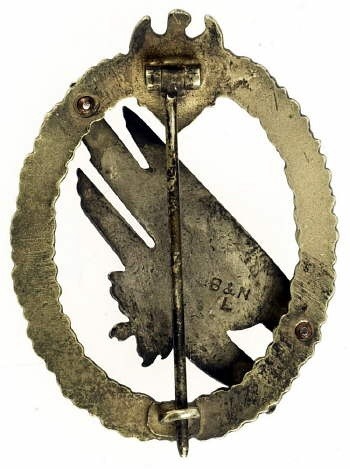 0
0 -
Greetings Pete! Thank you very much for this contribution. I should say that now that we have looked at genuine Army Para Badges, members are cordially invited to share the contents of their 'black museums' here. Coming back to this fake, we see the same 1957 pattern diving eagle but with the black finish as opposed to the silver finish. Below is the same type of fake, featured in Adrian's 1st Edition of Forman's Guide to Third Reich German Awards...And Their Values back in 1988.
So far, we have two types of fake made with these 1957-pattern eagles and sold to the collecting public by various high end dealers - or dealers who consider themselves high end - over the years. I remember the fury amongst some dealers when the first serious article on these badges was published on the web by Eric Queen and myself, with two notable dealers and website sponsor-advertisers who were especially livid because they had to make several reimbursements each.
One British dealer actually refused a customer a full refund on the grounds that the customer had devalued this badge by posting it on the web and asking for opinions, at which point it was identified as the "ghostbuster" fake. Another dealer in Germany gave refunds but imposed gagging orders. So, a French collector to whom I had given the bad news got his refund but I found myself confronted by scans of the very same fake badge some months later, back in 2003, after the dealer in question had once again sold it as an original to an American collector.
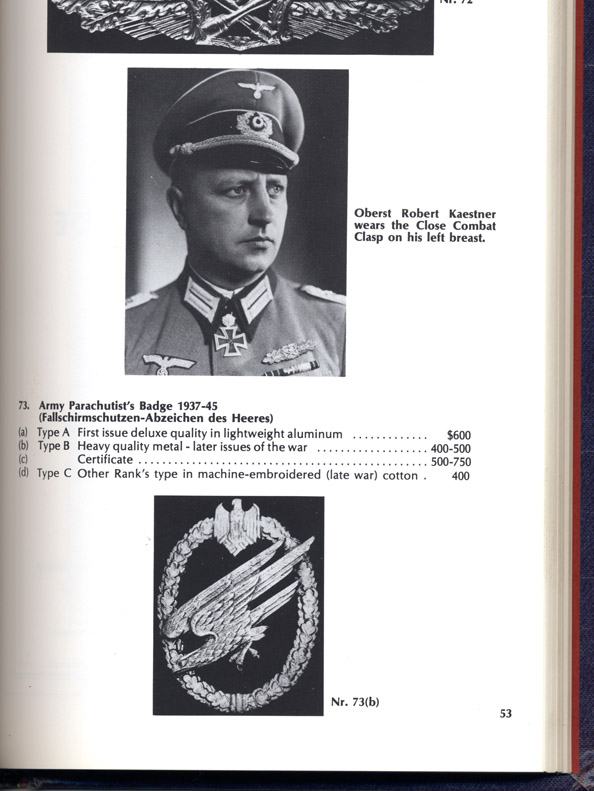 0
0 -
The same type of fake but with the angle of the diving eagle adjusted. This badge was offered by a leading German dealer with various postwar documents, including a 1952 attestation concerning a veteran's wartime service. The list of decorations and medals refers simply to the Fallschirmschützenabzeichen and includes the Narvik Shield. A couple of former Heer paratroopers went to Narvik so this could be a bona fide document and badge group formerly belonging to a Heer/Luftwaffe FJ veteran who acquired and improved one of the better copies of the Heer badge at some point, although he would only have worn this badge at very private reunions. SS-Fallschirmjäger-Btl 500? Unlikely. Brandenburger? Unlikely. Former Gebirgsjäger who jumped at Narvik? Perhaps, but they received the Luftwaffe badge. As a curiosity, the grouping is probably worth including in a 'one-of-everything' collection but the badge is a fake.
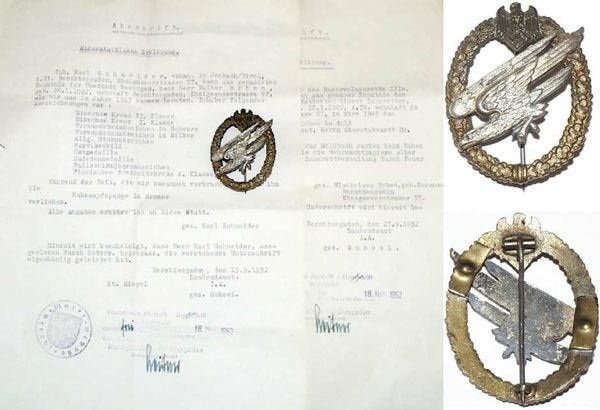 0
0 -
Obverse and reverse views of another type of fake badge. Although nothing like the real thing, a number of these particular fakes have been offered as 1943 pattern badges. Note the angle of the diving eagle, which is the same as the eagle from the 1957-pattern badge shown above. One dealer hooked his victim by suggesting that these were badges "made up locally" for Heer and Waffen-SS paras after the destruction of C E Juncker in an air raid in December 1944. While it is true that there was at least one small parachute training facility still in operation by this stage, two veterans who were trained there in advance of Operation Gryphon recalled receiving the cloth badge with the appropriate document, as was the practice in the parachute training schools from the middle of the war onwards. This would have been the Luftwaffe badge. The Brandenburg Division no longer had an active airborne element and SS-Fallschirmjäger-Btl 600 was airborne in name only.
 0
0 -
It's OK. I found I had some on file.
Thanks,
PK
0 -
The fake hallmark. If you find something like this on an Army Parachustist Badge, save your money.
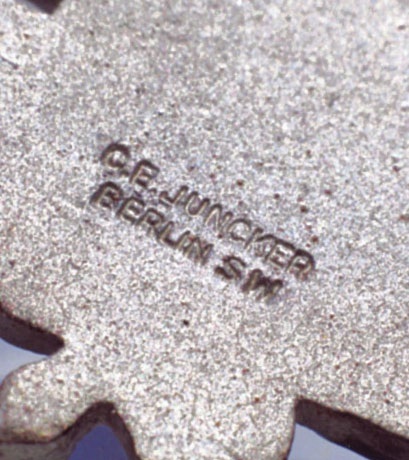 0
0 -
Another "Ghostbuster" badge, this example bearing the fake C E Juncker hallmark, modelled upon a wartime hallmark rather than that encountered on many prewar Juncker badges.
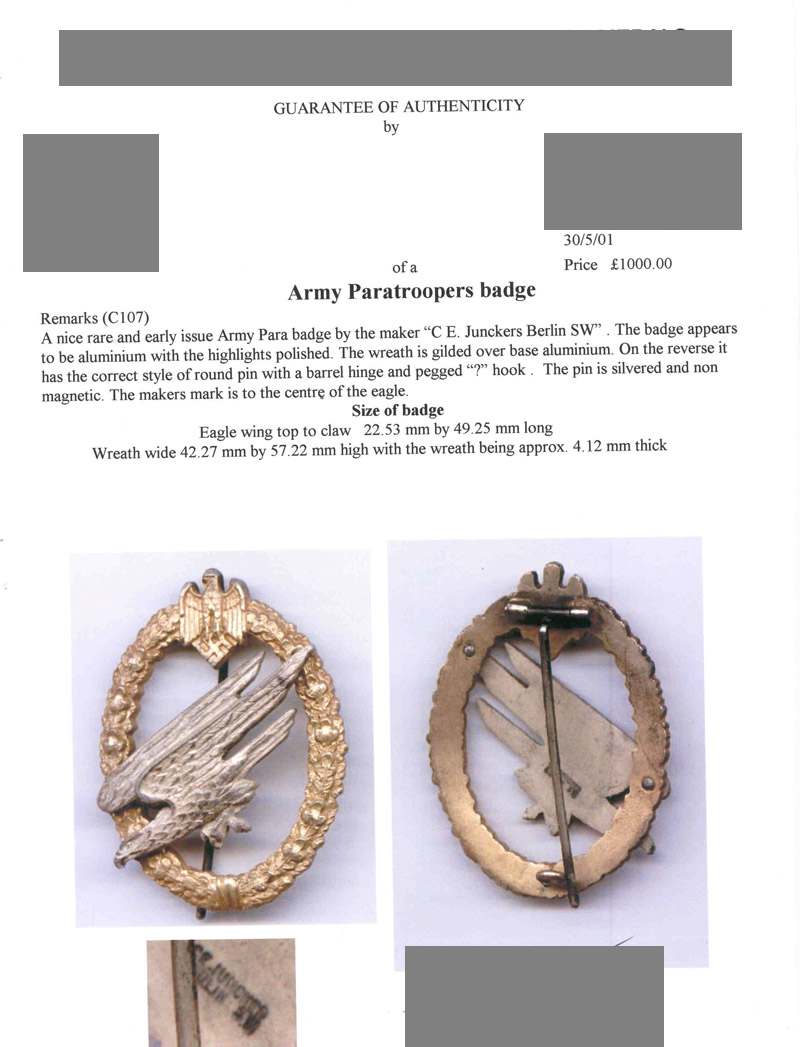 0
0 -
Another look at a genuine Type 2 eagle for your convenience. See the differences? Close...but no banana. And why should they be identical? They were struck as components for 1957 replacements although naughty people seem to have laid their grubby hands on a few batches and attached them to those horrible wreaths. They fooled a lot of people, nonetheless.
 0
0 -
The diving eagles used on these fakes are struck in aluminium, although not as high a grade as the originals, and are found on denazified 1957 pattern badges made for WW2 veterans. They look quite like the Army FSA eagle at a glance but once you put them side-by-side, they are not at all the same.
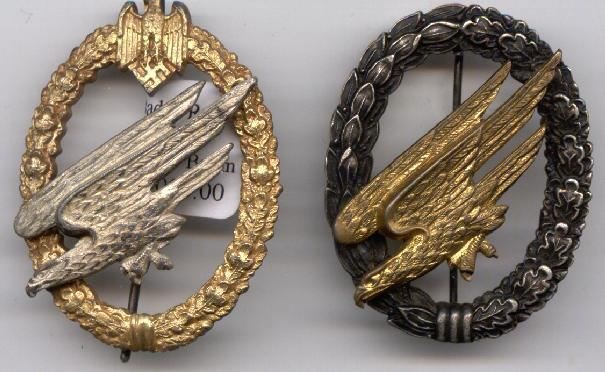 0
0 -
Here we have one of the more common fakes as sold by a number of dealers in the past. Note the “ghostbusters” or “Caspar the Friendly Ghost” silhouette of the Wehrmacht eagle when viewed from the back. Other points to note include the Question Mark hook rather than the correct C form hook and the odd-looking gold finish applied over some kind of black primer, used presumably to full in the blowholes in the cast aluminium wreath, which is not even cast from an original. These fakes are usually but not always marked with a fake and incorrect mid-war C E Juncker hallmark when, in fact, only three Juncker-marked Type 2 badges are known to exist. They have caught out many collectors and continue to be offered as original by dealers. This fake has been around since the 1970s and perhaps even as long ago as the late 1960s, according to some pundits.
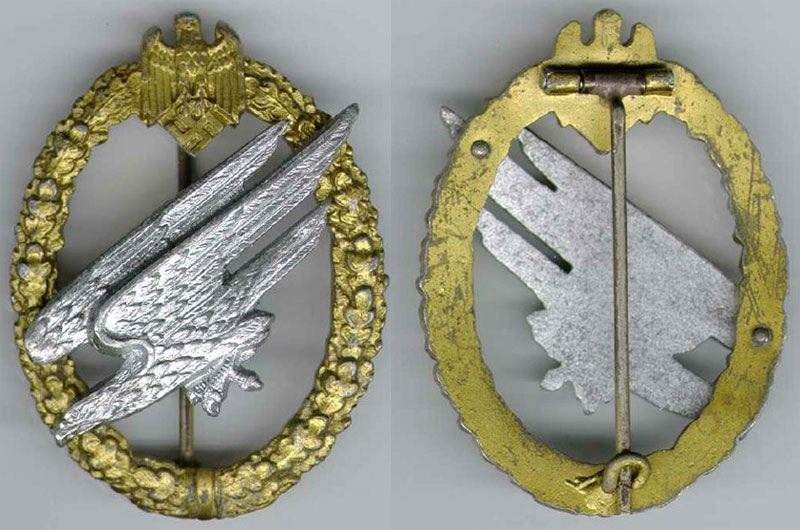 0
0 -
Before we move to fake badges, we should consider hallmarks. All of the known, original Type 1 and transitional aluminium badges bear the C E Juncker hallmark on the reverse of the diving eagle. There are a few Type 2 badges bearing the same hallmark, clearly applied with the same punch. Otherwise Type 2 aluminium badges were unmarked. So were the Type 3 badges in zink. Every one of the original silver badges bears the 800 hallmark on the reverse of the diving eagle.
Below, from left to right, are the hallmarks found on Type 1 badges, a few Type 2 badges and on the most common and, at one time, the most dangerous fake. The images are not as clear as they could be but should be sufficient to show you the differences. Note the proportions of the hallmarks and, especially, the rearwards-leaning 'L' in "Berlin" in the genuine hallmarks.
 0
0 -
A beautiful Type 2 silver badge with an unusual engraving format, suggesting that it might have been ordered as a gift by someone. To begin with, the personal and unit details are reversed and there is no record of such a rank as "Fallschirmfunker Unteroffizier". The "NZ" stands for Nachrichtenzug, which means Signals Platoon. The ball-ended safety catch remains intact. It has been suggested that this may have been a gift from Wittmann's comrades and that they might have offered his Wehrpaß as proof of entitlement.
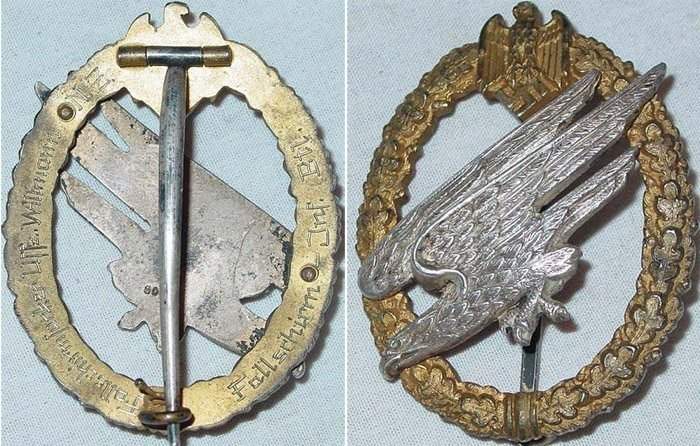 0
0 -
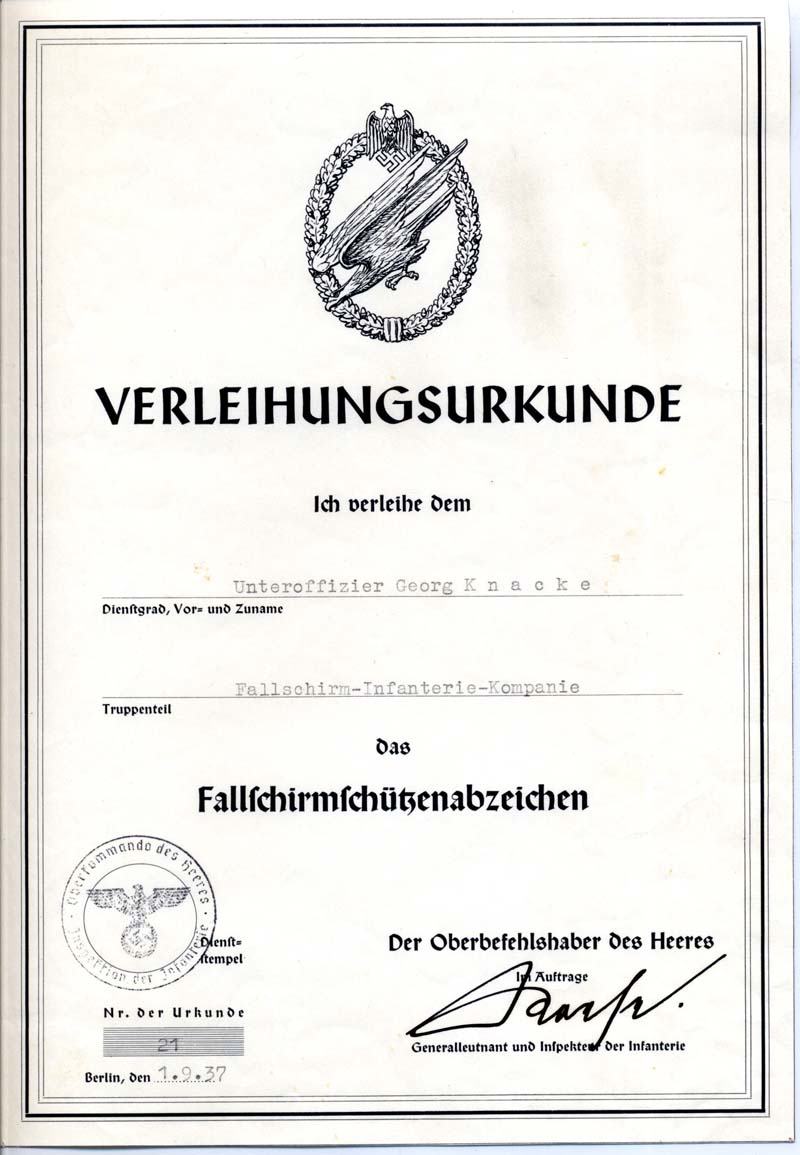
The documents have been faked but not terribly well. Here is a genuine document. One increasingly hears that fakers and forgers are capable of producing perfect copies but this is simply untrue. The problem is more a mixture of improved forgery and fakery, the telling imperfections and inaccuracies of which pass unnoticed by lazy collectors who do not research their chosen areas of interest before handing their money over to crooks. There are probably more documents to be discovered but only a few FIK men received them and a mere seventeen are currently known to survive. If you think you see a genuine one, there are only two people to ask and the other one, Eric Queen, knows much more about them than me.
 You would expect to pay upwards of €15,000.00 for one of these documents so when you see one on fleabay or Bunion's for two grand, forget it.
You would expect to pay upwards of €15,000.00 for one of these documents so when you see one on fleabay or Bunion's for two grand, forget it.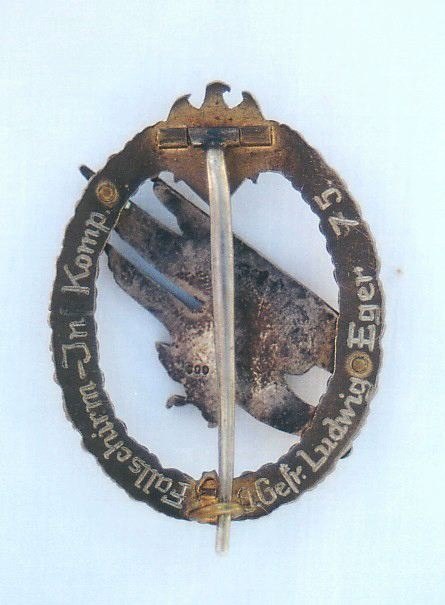
 0
0 -


Reverse and side views.
0 -
A better-preserved example to Ludwig Eger, which I wish I had bought when I had the chance. The ends of the little safety catch are missing. The engraving aside, these badges never had any hallmarks other than 800.
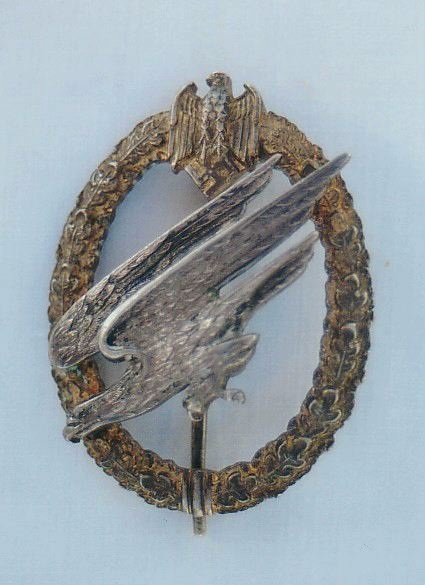 0
0 -
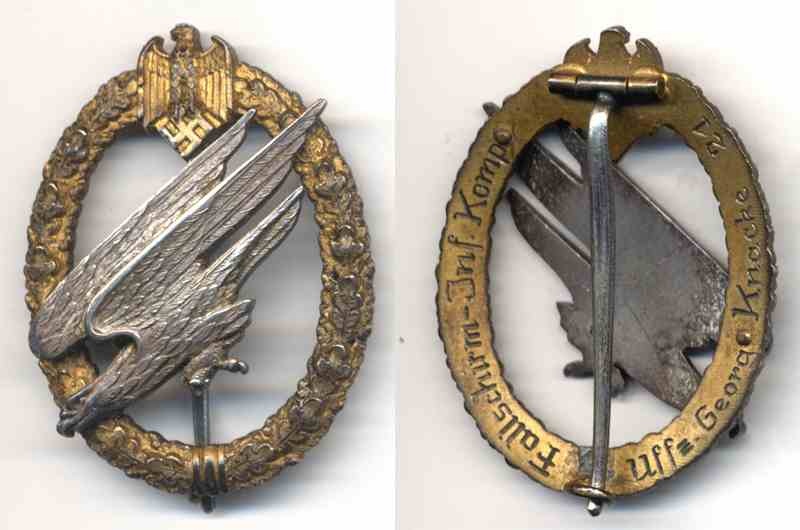
A number of collectors have been fooled by fakes of the Army Parachutist Badge in .800 silver. There are different kinds of fakes but the easiest way of avoiding an expensive mistake is to remember that C E Juncker struck these badges on the same dies as the aluminium official issue badges and that there currently are only fourteen or fifteen silver badges known to have survived. These comprise the three types, including three 'transitional' badges to Eger, Knacke and Leutlein, and an unengraved Type 2 in a Japanese collection.
These silver badges were private purchase items but the factory and its approved outlets required proof of entitlement in the form of the award certificate or the parachute licence (Fallschirmschützenschein) before engraving a silver badge with a man's details. In most cases, the silver badge bore the man's certificate number but there are exceptions, like the badge to Büttner, which bore the FSS number instead. As we have seen, at least one man, Sell, had an aluminium badge engraved by Juncker but as it is a Type 1 badge but with the unit given as Fallschirm Inf, Btl., we know that he must have had this done after June 1938 when the FIK was expanded into the Fallschirm-Infanterie-Bataillon even though his number #151 indicates that he was one of the first FIK men to receive a badge in September 1937.
Below is the transitional badge to Otto Leutlein #113, which surfaced in England a couple of years ago and was sold through Bosley's auction house. It is missing its safety catch, which is not serious, but appears to have been subjected to some sort of chemical cleaning process that has not only removed the gilding and frosting but given it the matt grey look one sees on old firearms subjected to cleaning chemicals by a certain type of educationally subnormal antique dealer. Nevertheless, it is currently for sale on a well-known dealer's website for €25,000.00.
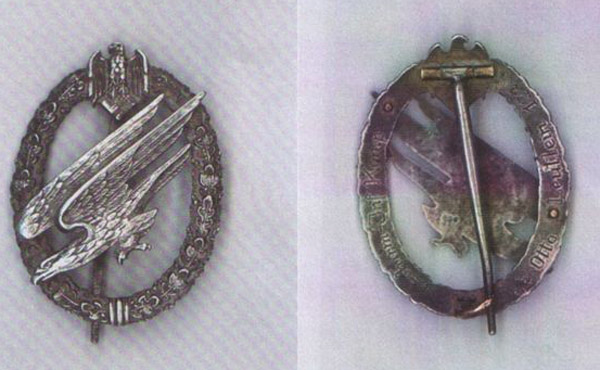 0
0 -
The FSA des Heeres in wear: taken aboard a KM vessel on the morning on 18.11.1943 after Unternehmen Taifun and the capture of the Greek island of Leros, this PK photograph shows, from left to right, a Brandenburger coastal raider, Dustin Hoffmann, a Brandenburger paratrooper from the 15. (Fallschirm) Kompanie and a Luftwaffe paratrooper from I./Fallschirmjäger-Rgt 2.
 0
0 -
The only detail variations encountered to date are the hooks. Most of the Type 3 badges have flat stock hooks but there are a few with hooks made of round stock.
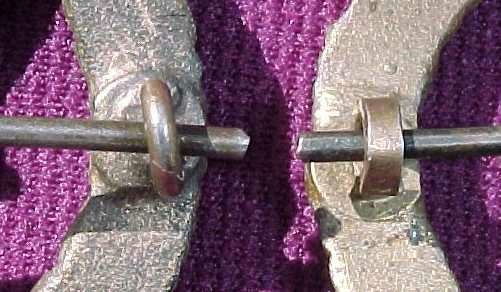 0
0 -
Front and rear views of the 1943/44 FSA des Heeres. Note the hinge and hook assemblies characteristic of zink or monkey metal badges, the small domed rivets and the file work. C E Juncker's artisans put just as much work into the finishing of these badges as their prewar counterparts. They are of a very high quality, despite the debased materials. The pin is blued steel.
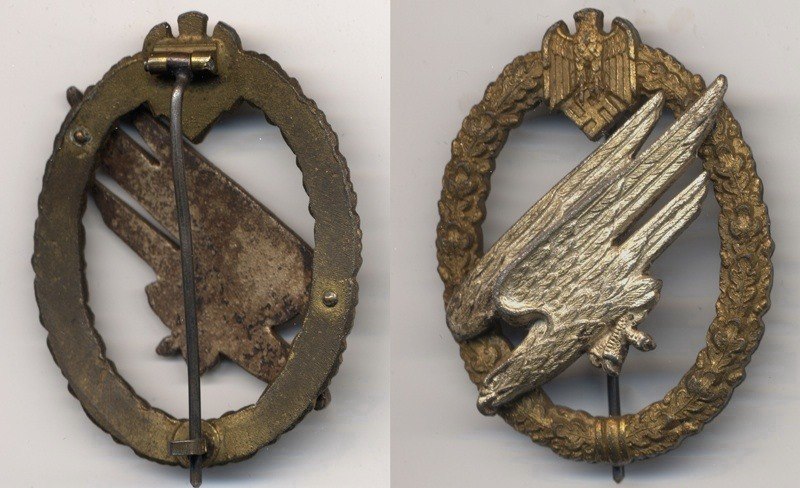 0
0 -
With the expansion of the Brandenburg Division’s parachute capability as the war ground on, the OKH decided to reinstitute the Army Parachutists’ Badge as of 1.6.1943. There was a slight alternation in nomenclature from Fallschirmschützenabzeichen (Heer) to Fallschirmschützenabzeichen des Heeres. The first recipients of the FSA des Heeres were parachutists of the 15 (Fallschirm) Kompanie of the 3rd Battalion of the Brandenburg Division’s 4th Light Infantry Regiment.
The FSA des Heeres was struck in feinzink by C E Juncker on the same dies used to produce the prewar Type 2 badges. Some surviving mint examples show us that the finish was of quite a high quality, with gold-washed wreaths and silver-washed diving eagles, complete with frosted highlights. Most of the surviving Type 3 badges have retained their finish surprising well by comparison with many mid to late-war zink combat and award badges. I have only seen a couple of grey examples out of the twenty or so originals I have handled. In general, the gold finish tends to have dulled a bit but the diving eagle is often still quite bright.
From a collector’s viewpoint, it is important to bear in mind that any German military personnel qualifying as parachutists between 1.1.1939 and 1.6.1943 received the Luftwaffe pattern Parachutists’ Badge. As a sidenote, parachute training was conducted exclusively by the Luftwaffe and there was no difference between the training for Heer and Luftwaffe candidates nor, for that matter, Waffen-SS parachutists. February 1944 saw the formation of Fallschirmjäger-Bataillon “Brandenburg” at Stendal under the command of Hauptmann Weithöner although 15 (Fallschirm) Kompanie remained on the Brandenburg Division’s OOB as an independent sub-unit under the command of Oblt Oschatz. For more information on Brandenburger paratroopers, follow this link - http://germanmilitaryhistory.devhub.com/blog/2009/10/09/brandenburg-paratroops - for an article by Eric Queen and myself.
In September 1943, following the successful rescue of Italian leader Benito Mussolini from his hotel prison on Gran Sasso by Lufwaffe Fallschirmjäger and a small number of Waffen-SS commandos under the command of Otto Skorzeny, who hijacked the operation in terms of personal public relations, Adolf Hitler ordered the formation of a Waffen-SS parachute battalion. SS-Fallschirmjäger-Btl 500 was formed in October 1943 and moved to the Serbian garrison town of Kraljevo the following months.
No photographs have yet surfaced of Waffen-SS paratroopers wearing the FSA des Heeres, although the retouched colour photo-portrait of SS-Ustuf Walter Scheu depicts the FSA des Heeres and his paybook shows the entry for the badge. Two of the A5 certificates for the badge survive to Waffen-SS men, one of them still living, as well as one other known paybook entry. The majority appear to have received the Luftwaffe badge. Suffice to say, with regard to the FSA des Heeres, that there were not enough badges for the entire complement of SS-Fallschirmjäger-Btl 500, suggesting that most of the stock of badges went to the Heer’s Brandenburg paratroopers, leaving only enough available for a comparitively small number of the Waffen-SS men passing through Fallschirmschule III in Mataruska Banja, near SS-Fallschirmjäger-Btl 500’s garrison town of Kraljevo. In summary, therefore, there were perhaps two or three production runs of the Type 3 zinc badges but certainly no more because there were not enough available at the time for two battalions and a company.
In August 1944, as our article says, two companies of FJ-Btl "Brandenburg" participated in the Relief of Bucharest to rescue the German command there and their troops, who were surrounded by a force of Romanian turncoats who had thrown their lot in with the Soviets. A small assault group parachuted into Otopeni airport and secured it for the airlanding of the main relief force, which included two companies of the Brandenburg's 3rd Regiment, in Me323 gliders. Once the Brandenburgers had restored order, the Romanians agreed to allow German forces in and around Bucharest safe passage to the frontier. Many of the Romanians stated that they were still loyal to their German allies. However, no sooner had the German column quit the city, the Romanians betrayed them to the waiting Soviets. Few if any of the Brandenburgers survived Soviet captivity. The ORBAT of FJ-Btl Brandenburg was reduced by half as a result of the Bucharest mission, the point being that many Type 3 badges must have disappeared eastwards with them and that the Type 3 badge, far from being the poor cousin of the high quality prewar badges, is just as rare.
 0
0 -
In order to understand the rarity of the badge, you need to know a little about the units and personnel eligible for the Army Parachutists’ Badge because the more you know about the badge and its award criteria, the less vulnerable you will be to the smoke and mirrors pitches of the numerous con artists trying to part you from your hard-earned money.
The Fallschirmschützenabzeichen (Heer) was instituted on 1.9.1937 by order of Generaloberst Freiherr von Fritsch, Commander-in-Chief of the German Army, for trained paratroopers of the Heer’s Fallschirm-Infanterie-Kompanie, formed by the OKH on 1.4.1937 in Stendal. The first badges were awarded to approxomately 170 FIK men at the end of the autumn manoeuvres in Mecklenburg by Hauptmann und Kompaniechef Zahn. These would obviously have been Type 1 badges.
The FIK was expanded to battalion strength on 1.6.1938 as the Fallschirm-Infanterie-Bataillon and Zahn relinquished command to Major Richard Heidrich, a WW1 veteran who won the respect of his men by qualifying as a paratrooper at the age of 42. The FIB was placed under the operational command of the Luftwaffe’s 7. Fliegerdivision on 1.7.1938 and eventually became part of the Luftwaffe on 1.1.1939 as II./Fallschirmjäger-Regiment 1. Although former FIK/FIB men continued to wear their Heer jump badges with pride throughout the war, the badge was abolished as of 1.1.1939 with the unit’s transfer from the Heer to the Luftwaffe. There were just over 850 awards of the FSA (Heer).
To summarise, therefore, there was perhaps one production run of the Type 1 badge in 1937 before the revisions to the design, followed by two or, at most, three production runs of the Type 2 badges before the abolition of the FSA (Heer) at the end of 1938. A typical minimum production run would have been 500 units. The Type 2 badge also underwent minor revisions, the main one being the thickening of the wreath by 0.5mm so the production statistics would probably have been broken down into one run of Type 2a and one or two runs of Type 2b badges. The FSA (H) was produced exclusively by C E Juncker of Berlin for the OKH. It is unlikely that any aluminium badges were produced after January 1939 because many of the original examples obtained from or examined in the possession of recipients and their families have several period repairs and show high degrees of wear, indicating that replacements for these relatively fragile badges were hard to find even at the time. FIB veteran Alfred Ludwig recalled finding one in a shop in 1942. This badge, which is in Eric Queen's collection, is one of the few Type 2s known with the maker’s hallmark found on all Type 1 aluminium badges, is very worn and has several period repairs.
The cases for the FSA (H) are extremely rare and good photographs can be found in Eric Queen's book Red Shines The Sun. There are two types known. Of the award certificates issued on 1.9.1937 and 18.12.1937, a mere seventeen are currently known to survive.
 0
0 -
Before moving away from the prewar aluminium badges, here is a large scan of the Type 2 obverse for study and reference purposes. If you have a Type 2 badge in aluminium, silver or a Type 3 badge in zink and its die-struck surface details do not correspond precisely to what you see here, it is a copy or a fake.
 0
0 -
Another Type 2a badge.
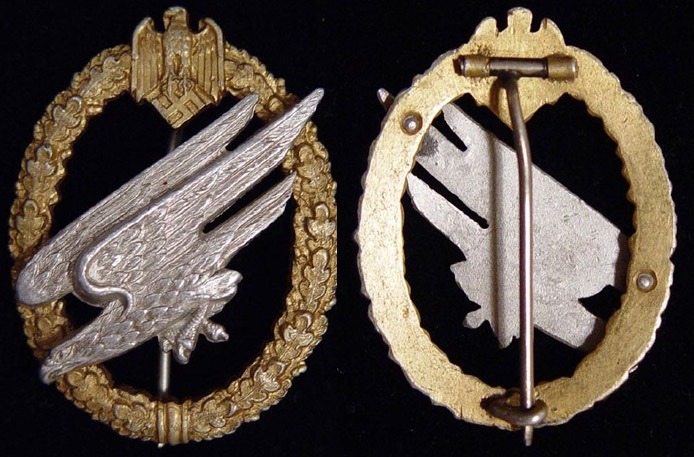 0
0 -
Wrong image but, hey, it won't do you any harm to keep looking at genuine badges before we get to the various fakes out there.
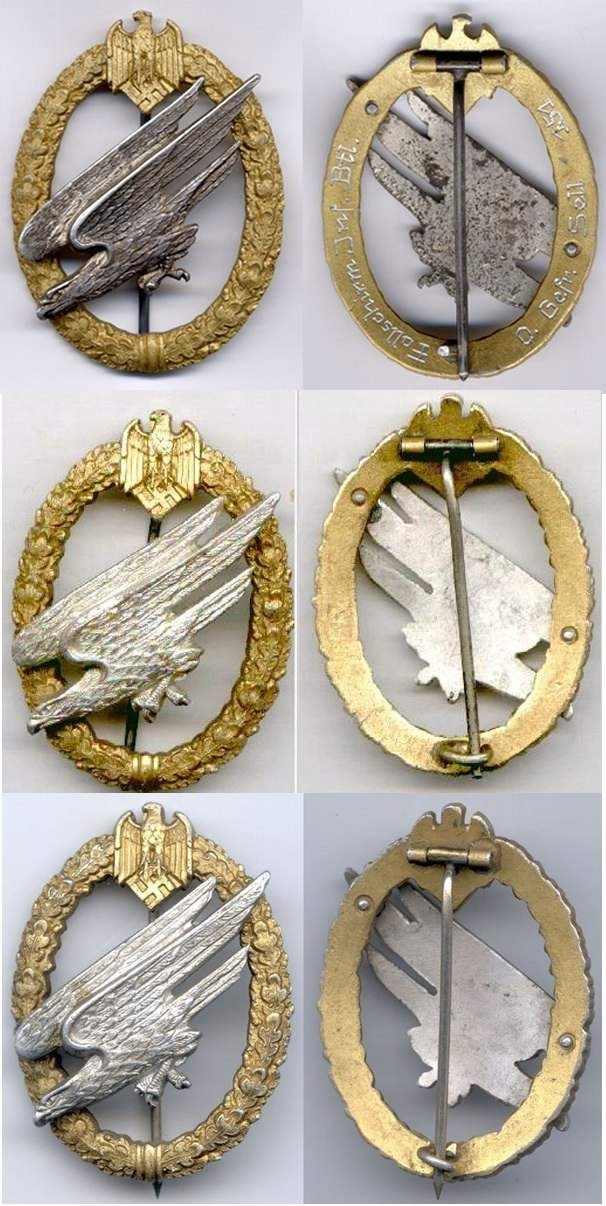 0
0




Lucien Barroy dit «Ali Baba»
in France
Posted · Edited by PKeating
I think you and Chris are right in that he added some of these "décorations" himself. However, I have been able to establish that he was indeed the commander or "chef" of the Tours-Angers-Le Mans sector of the Organisation Résistance de l'Armée whose resistance pseudonym was "Ali Baba". Apart from the wartime and postwar veterans' association stamps certifying this, he is listed in a number of official files. As he was an officer, I think there must be a personnel file on him somewhere. Whether I would be permitted to research that file is another matter.
The ORA was one of those groups that found itself subject to a certain amount of Gaullist "airbrushing" after the war, like the FTPC and other groups that were in no hurry to swear allegiance to General de Gaulle. The ORA was, after all, set up by Vichy officers whose leader was the man presiding over the tribunal that sentenced Charles de Gaulle to death in 1940 and many of the members would have described themselves as sympathetic to General Giraud, before Giraud threw in his lot with the Gaullists once it started becoming clear, as the Axis war effort started to falter and Vichy's future looked less and less sure, that the choice facing France was stark: Gaullist conservatives or Moscow-friendly Bolsheviks. Charles de Gaulle was the right man for the job of restoring order in France. Had anyone else been in charge, an already violent post-Liberation situation might have degenerated into open civil war. Most ORA men saw the sense in this, which is why the ORA allowed itself to come under FFI command, although it jealously guarded its operational autonomy, like the FTPC.
I would have expected to see medals like the 1939-1945 Commemorative with, perhaps, a LIBÉRATION bar and the French Resistance Medal. Maybe the "Croix commémorative de la Libération" was his way of referring to the War Medal with the Liberation bar, given that incorporates the Cross of Lorraine in the obverse design. He must have added those entries in the 1950s or 1960s. Maybe even later than that. However, these are details. I bought the paybook because Lucien Barroy dit Ali Baba was certainly the commander of an important resistance group in a part of France I know very well and as Roel says, there is more research to be done.
Thank you all for your remarks and comments, which have been very helpful indeed.
PK